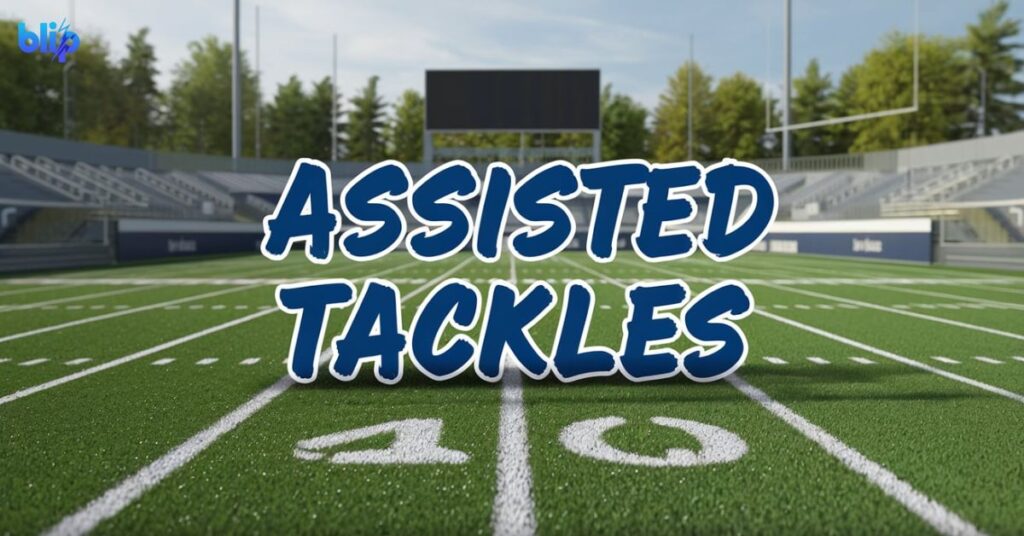The COMB football stat is a crucial metric in football defense. It stands for Combined Tackles and provides a comprehensive view of a player’s tackling performance. This statistic helps coaches, scouts, and fans understand a defender’s impact on the game.
COMB adds up solo and assisted tackles, giving us a fuller picture of a player’s defensive contributions. It’s not just about big plays – the COMB football stat shows who’s consistently in the right place at the right time to stop the opposition.
In this article, we’ll dive deep into what COMB means, how it’s calculated, and why it matters. We’ll explore how the COMB football stat is used to evaluate players and its role in both real and fantasy football. Let’s tackle this important defensive metric!
Breaking Down the COMB Stat
The COMB football stat consists of two main components: solo tackles and assisted tackles. Each type of tackle contributes differently to a player’s overall COMB number, reflecting the various ways defenders can impact a play.
Solo tackles occur when a single defender brings down the ball carrier without help from teammates. These plays showcase individual skill and often lead to highlight-reel moments. In the COMB football stat, solo tackles typically carry more weight than assisted tackles.
Assisted tackles happen when two or more defenders work together to stop the ball carrier. While perhaps less glamorous than solo tackles, they’re crucial for team defense. In the COMB football stat, assisted tackles usually count as half a tackle for each player involved.
The Many Faces of COMB in Football
COMB means different things in football. It can be a player’s hairstyle on the field. It can also mean a team’s playing style. Some teams use a mix of skills like a comb’s teeth.
Football teams can “comb” through their opponent’s defenses. This means finding weak spots to attack. Coaches also “comb” through game footage. They look for ways to improve their team’s performance.
Solo Tackles
The COMB football stat places high value on solo tackles. These are plays where a single defender brings down the ball carrier without assistance. Solo tackles demonstrate a player’s skill, strength, and ability to read the game.
In terms of the COMB football stat, solo tackles typically carry full weight. This means each solo tackle adds one full point to a player’s COMB total. As a result, players who excel at making solo stops often have impressive COMB numbers.
The importance of solo tackles in the COMB football stat can sometimes overshadow other crucial defensive skills. While they’re important, focusing too much on solo tackles might not give a complete picture of a player’s defensive contributions.
Assisted Tackles

Assisted tackles, the other component of the COMB football stat, occur when two or more defenders work together to stop the ball carrier. These plays highlight the collaborative nature of good defense and are crucial for overall team performance.
In most COMB football stat calculations, assisted tackles count for half a point. This means that if two players assist on a tackle, each gets 0.5 added to their COMB total. This system recognizes the contribution of multiple players in stopping the offense.
While assisted tackles might seem less impressive than solo tackles in the COMB football stat, they’re often indicative of good team defense. Players who consistently assist on tackles are valuable for their ability to support teammates and limit offensive gains.
COMB and Player Positioning
The COMB football stat can vary significantly based on a player’s position on the field. Linebackers and safeties, for instance, often have higher COMB numbers due to their central roles in both run and pass defense.
Defensive linemen might have lower COMB football stat numbers, but this doesn’t necessarily reflect less impact. Their role in occupying blockers and disrupting plays often creates tackling opportunities for linebackers and defensive backs.
Cornerbacks typically have the lowest COMB football stat numbers among defensive players. This is largely due to their primary responsibility being to pass coverage rather than run-stopping. A high COMB for a cornerback can indicate exceptional all-around defensive play.
The Impact of COMB on Game Strategy
Coaches and coordinators often use the COMB football stat when developing game plans. They might design plays to avoid defenders with consistently high COMB numbers, recognizing these players as key stoppers on the opposing defense.
Conversely, defensive coordinators might position their high-COMB players strategically to maximize their impact. The COMB football stat can help identify which defenders are most reliable at making stops in crucial situations.
Relying too heavily on the COMB football stat for strategy can be risky. Smart offensive coordinators know that COMB doesn’t tell the whole story and may exploit defenses that focus too much on tackling stats at the expense of other defensive skills.
COMB’s Role in Player Contracts and Negotiations
The COMB football stat often plays a significant role in contract negotiations for defensive players. Consistently high COMB numbers can be used as evidence of a player’s value and impact on the field.
Teams are becoming increasingly sophisticated in how they use the COMB football stat in negotiations. They may look at factors like tackle quality, play impact, and other defensive contributions not captured by COMB.
Players and agents also use the COMB football stat in negotiations but must be prepared to contextualize these numbers. They might need to demonstrate how a player’s COMB contributes to overall team defense or complements other valuable skills not reflected in tackling stats.
COMB’s Role in Player Evaluation

Coaches and scouts rely heavily on the COMB football stat when assessing defensive players. It provides a quantifiable measure of a player’s involvement in stopping the opposing offense. it’s important to note that COMB is just one piece of the evaluation puzzle.
When using the COMB football stat, evaluators consider the player’s position and role within the defense. For example, a middle linebacker might be expected to have a higher COMB than a cornerback due to their different responsibilities on the field.
Over time, trends in a player’s COMB football stat can reveal valuable insights. Consistently high numbers might indicate a reliable tackler, while sudden drops could signal issues with performance or scheme fit. context is key when interpreting these trends.
Key Factors Affecting COMB
Several factors can influence a player’s COMB football stat:
- The team’s overall defensive strategy.
- The opponent’s offensive style and game plan.
- Game situations (e.g., playing with a lead vs. trailing).
- Weather conditions affect play style.
- The player’s specific position and role in the defense.
COMB Across Different Positions
The COMB football stat varies significantly across different defensive positions:
| Position | Typical COMB Range (Per Season) |
| Linebacker | 80-120 |
| Safety | 60-100 |
| Defensive Line | 30-60 |
| Cornerback | 40-80 |
These ranges are general guidelines and can vary based on individual players, team schemes, and other factors. The COMB football stat should always be considered in context with other metrics and game films.
COMB and Game Strategy
The COMB football stat can significantly influence game planning on both sides of the ball. Offensive coordinators might design plays to avoid high-COMB defenders, while defensive coordinators may position their top tacklers strategically.
Players with consistently high COMB football stat numbers often become focal points of the opposing team’s game plan. This attention can create opportunities for other defenders, highlighting the broader impact of strong tacklers.
Coaches also use the COMB football stat to identify potential mismatches or weak points in the opposing defense. This information can be crucial when designing offensive strategies for upcoming games.
Read this Blog:How Tech Etruesports is Shaping the Future of Gaming
Limitations of the COMB Stat

While the COMB football stat is valuable, it has its limitations. It doesn’t differentiate between a tackle made after a short gain and one made downfield after a long play. Both count equally in COMB, despite their different impacts on the game.
The COMB football stat also doesn’t capture other crucial defensive skills like pass coverage, quarterback pressure, or the ability to shed blocks. These skills can greatly impact a game but aren’t reflected in COMB numbers.
Some argue that the COMB football stat can be biased towards certain positions or defensive schemes. Players who are closer to the line of scrimmage or in run-heavy defenses may naturally accumulate more tackles, potentially inflating their COMB numbers.
COMB in Fantasy Football
In fantasy football, the COMB football stat often plays a significant role, especially in Individual Defensive Player (IDP) leagues. High COMB numbers usually translate to more fantasy points, making prolific tacklers valuable assets.
Fantasy players often use the COMB football stat as a key metric when drafting defensive players. Consistency in COMB can indicate a reliable week-to-week scorer, which is crucial in fantasy matchups.
Savvy fantasy players know to balance the COMB football stat with other metrics. Big-play potential (like interceptions or sacks) can sometimes outweigh pure tackle numbers in certain scoring formats.
How COMB Compares to Other Stats
The COMB football stat is just one of many defensive metrics used in football analysis:
- Tackles for Loss: Shows a player’s ability to make plays behind the line of scrimmage
- Sacks: Measures a defender’s success in taking down the quarterback
- Interceptions: Counts passes caught by the defense, a key turnover stat
- Forced Fumbles: Indicates a player’s knack for creating turnovers
- Pass Deflections: Tracks a defender’s ability to break up passing plays
Future of COMB in Football Analysis

As football analytics continue to evolve, so does the use and interpretation of the COMB football stat. Advanced metrics are being developed to provide more context to raw tackle numbers, giving a more nuanced view of defensive performance.
Some teams are now combining the COMB football stat with GPS data to analyze tackle locations and efficiency. This approach provides a more comprehensive understanding of a player’s defensive impact beyond just the number of tackles.
Fan engagement with defensive stats is also growing, with the COMB football stat often at the forefront. As fans become more stat-savvy, we can expect to see even more detailed breakdowns and analysis of tackling performance in broadcasts.
Tips for Improving COMB
Players looking to boost their COMB football stat can focus on:
- Refining tackling technique for more successful takedowns
- Studying opponent tendencies to better anticipate plays
- Improving play recognition skills to react faster
- Maintaining peak physical condition for consistent performance
- Enhancing communication with teammates for better defensive coordination
Final Words
The COMB football stat remains a cornerstone of defensive player evaluation in football. It provides a clear, quantifiable measure of a player’s involvement in stopping the opposing offense. While it has its limitations, COMB continues to be a valuable tool for coaches, scouts, and fans alike.
As we’ve seen, the COMB football stat is more than just a number. It reflects a player’s consistent effort, their role within the defense, and their ability to be in the right place at the right time. When used alongside other metrics and game film, COMB offers valuable insights into defensive performance.
No single statistic tells the whole story of a player’s impact. The COMB football stat is most effective when considered as part of a broader evaluation that includes various metrics, game context, and on-field observations. It’s this holistic approach that truly captures the complexity and excitement of football defense.
Frequently Asked Questions
What’s considered a good COMB number for a linebacker?
While it varies, top NFL linebackers often record 100+ combined tackles in a season.
Does the COMB stat include tackles made on special teams?
Typically, COMB only counts tackles made during defensive plays, not on special teams.
Can the COMB stat be misleading?
Yes, as it doesn’t show tackle quality or other important defensive contributions.
How often is a player’s COMB stat updated?
COMB is usually updated after each game, with season totals accumulating throughout the year.
Do all football leagues use the COMB stat?
Most professional and high-level amateur leagues use COMB, but some may use different tackling metrics.

Raina Johnson is a passionate sports author on Techsblip , focused on delivering insightful and well-researched content that connects sports enthusiasts with the heart of the game. With a deep understanding of sports history, trends, and culture, Raina’s writing inspires readers to appreciate the beauty of competition, teamwork, and human achievement.

